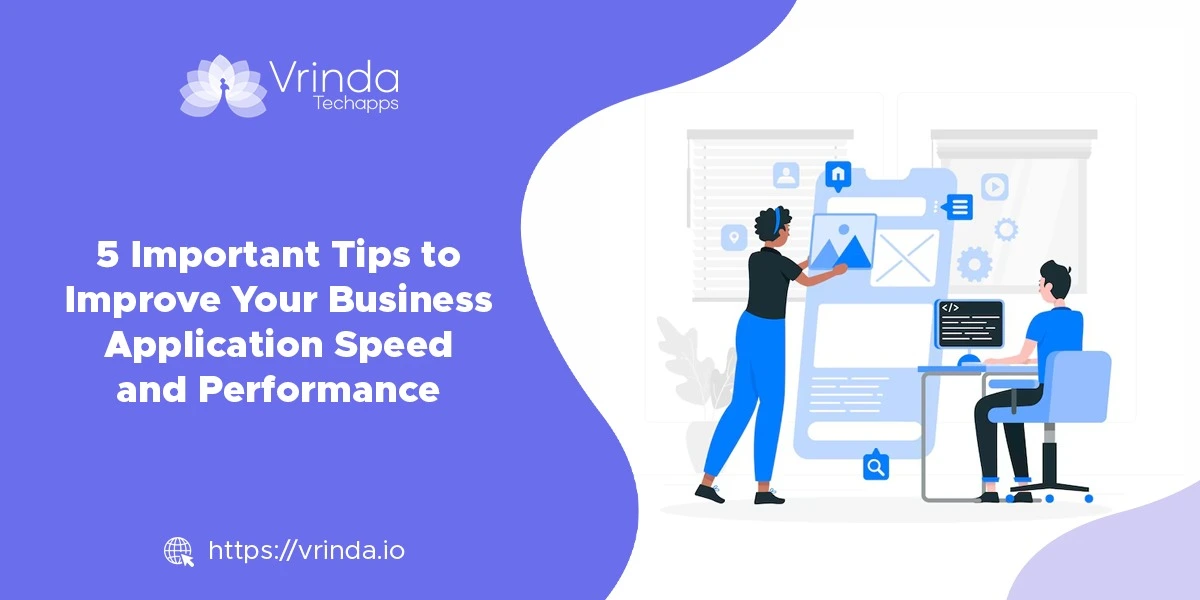
5 Important Tips to Improve Your Business Application Speed and Performance
- December 20, 2023
- 8 min read
In today’s competitive market, business operations require dynamism, speed, and a strong focus on customer satisfaction. Mobile applications emerge as crucial tools, placing companies literally at their customers’ fingertips, offering quick access and seamless secure transactions through smartphones.
But this is possible only when your mobile application is fast, efficient, and secure. While a well-functioning mobile app helps you boost business performance and customer retention, an inefficient app can be equally damaging to a business. If the app processing is slow, or if the application crashes unexpectedly, it causes great inconvenience to the user.
So, the mobile application’s performance can directly impact business reputation, and this is why you need to ensure that your mobile apps are all functioning smoothly and securely. In case you have speed and performance issues with your mobile applications, contact a top flutter mobile app development company and use only professional mobile application development services to correct the issues.
Here are five key areas professional developers focus on to boost a mobile application’s speed and overall performance.
1. Code Optimization
Any professional service provider will tell you to begin code optimization when it comes to mobile app performance. Coding errors can cause several issues with an application’s performance, so before making other changes, you must work with your professional Flutter mobile app development service provider and optimize the codes. Professionals use several techniques such as code splitting, cache management, minification, compression, etc., to reduce the overall size and enhance the accessibility and loading speed of the application.
2. Media Optimization
The next crucial part of a mobile is the media it contains. Images and videos require more time to load depending on the user’s internet speed and the size of the media. So, professional developers strategically analyse the entire application and optimize the media based on its priority. Images and videos that display key application features are kept intact while other low-priority media and images are compressed efficiently to boost the page loading time and speed.
3. Streamlined Data Transfer
An app’s speed is significantly influenced by how it manages network requests and data transfers. Streamlining these processes can have a direct impact on the app’s overall performance.
Professional mobile application development services may focus on the following key areas to optimize the data chain of your business applications-
- Minimize HTTP Requests- Reduce the number of HTTP requests by consolidating resources. Combine multiple files into a single request wherever possible to enhance loading speed.
- Content Delivery Networks (CDNs): Leverage CDNs to distribute your app’s static content across various servers globally. This ensures users can access resources from servers geographically closer to them, reducing latency.
Implement Caching Mechanisms: Utilize caching for both client-side and server-side resources. Cached data can be quickly retrieved, reducing the need for repeated network requests and enhancing overall app speed.
4. Boost Responsiveness By Optimizing Background Processes and Multi-threading
While your app is busy performing tasks in the background, users expect it to remain responsive. Implementing background processes and multithreading can significantly improve overall responsiveness and user experience. This is why professional developers prioritize background processing optimization to boost app UX.
Here are some key areas that can be optimised to improve application responsiveness and background data processing.
- Asynchronous Operations: Execute time-consuming operations asynchronously to prevent the main thread from becoming blocked. This ensures the app remains responsive, even during resource-intensive tasks.
- Multithreading-Multi-threading enables concurrent execution of multiple tasks. This ensures that one task doesn’t obstruct other background processes, resulting in a smoother and more responsive user experience.
- Optimize Background Tasks: Review and optimize background tasks to minimize their impact on the app’s foreground performance. Prioritize essential tasks and consider user experience when implementing background processes.
5. Regular Performance Monitoring and Testing
Performance optimization is an ongoing process that requires consistent monitoring and testing. Regularly analysing your app’s performance metrics and conducting thorough testing allows you to identify potential bottlenecks and areas for improvement.
Focus on the following areas to ensure smooth application performance in the long run-
- Usage Analytics: Implement analytics tools to track user interactions and identify patterns. This data can help pinpoint areas of the app that may need performance enhancement.
- Real-time Monitoring: Utilize real-time monitoring tools to track the app’s performance in various scenarios. Identify any anomalies or slowdowns promptly and take corrective action.
- User Feedback: Actively seek and analyse user feedback regarding app performance. User comments and reviews can provide valuable insights into potential issues that may not be immediately evident through metrics alone.
Conclusion
In the competitive arena of business mobile applications, delivering a fast and efficient user experience is crucial. So, the best option is to contact professional mobile application development services and conduct a thorough analysis of your mobile applications. Working with professionals to understand the above-mentioned 5 crucial optimization areas, is the most efficient method of maintaining top performance with your business apps.



